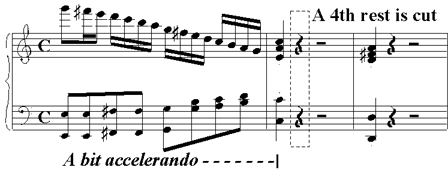| Music Home | All lists | Beethoven | Brahms | Schubert | Others | Liner Notes | Tedious | License(Korean) | Hall of Shame | Korean |
5. Problems of HS-2088 series by Toshiba-EMI
Toshiba-EMI's HS-2088 series(High Sampling rate 20bit/88.2kHz) surely succeeded commercially, but raised considerable disputes in Korea. It was mainly due to not only its sound quality but also musical problems - different playing time from former versions, signal dropout, and misseditings. To the extent of my knowledge, minimum four record reviewers in Korea (including me) pointed out problems of this series. The reviews are here.
1) BEETHOVEN ; Symphony No.5 in c minor, op.67
SCHUBERT ; Symphony No.8 in b minor, D.759 "Unfinished"
- Wilhelm Furtwängler/Vienna Philharmonic
- Record No. ; TOCE-3004
- Contribution ; The Classical Music, No.3(Nov. 1996)
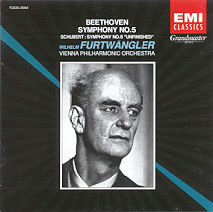 |
... Sound quality of this
CD is better than the international version(EMI
CDH 7 69803 2), but it's very unhappy that I can
find some serious problems. First, playing time
is different from former versions ;
As seen from upper table, Beethoven is shorter and Schubert is longer. This give subtle difference in listening, which is so difficult to be explained by words*. |
|||||||||||||||||||||||||||||||||||
2) BERLIOZ ; Symphonie Fantastique, op.14a
- Charles Munch/Orchestre de Paris
- Record No. ; TOCE-3036
- Contribution ; Hwaseop LIM, The Classical Music, No.1(June 1996) [ by courtesy of the author ]
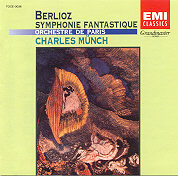 ... Is
this reissue successful? Frankly speaking, I think this
has some problems, which is obvious even if it is not
compared to international version(EMI CDC 7 47372 2). Volume level is so high as
to cause distortion by volume saturation - the international version has no such a
problem, at least(I think it's basic concept to control
master volume following fortessimo level in producing
CD). There are
several points with dropout - playing time 3:46 of 1st
mvt., etc.(I can't
ascertain what results in dropout - defect of source
tape, missediting in the remastering, and CD processing)
Toshiba-EMI overused frequency filtering(especially, bass
hums too much) and raised volume in this CD. I cannot but
doubt this is "the remastering reflected sound of
LP". I can't know what is the difference from 20-bit
remastering at least in listening this CD.
... Is
this reissue successful? Frankly speaking, I think this
has some problems, which is obvious even if it is not
compared to international version(EMI CDC 7 47372 2). Volume level is so high as
to cause distortion by volume saturation - the international version has no such a
problem, at least(I think it's basic concept to control
master volume following fortessimo level in producing
CD). There are
several points with dropout - playing time 3:46 of 1st
mvt., etc.(I can't
ascertain what results in dropout - defect of source
tape, missediting in the remastering, and CD processing)
Toshiba-EMI overused frequency filtering(especially, bass
hums too much) and raised volume in this CD. I cannot but
doubt this is "the remastering reflected sound of
LP". I can't know what is the difference from 20-bit
remastering at least in listening this CD.
There are many strangenesses in
the Grandmaster remastering of orchestral works. Why did
the sound of Furtwangler become lean? Though I consider
Japanese remastering style(increasing signal level and
emphasizing treble and bass), could the condition of
which the master Toshiba used be so bad that I was able
to find dropout which there is not in international
version? Is the
missediting error in Furtwängler's Beethoven 5th symphony only a
small mistake, or the tip of the iceberg?
I saw an interview article HS-2088 remastering staffs said experts always inspect their remastering before releasing. I want to put a question to them ; What did the experts do on earth?
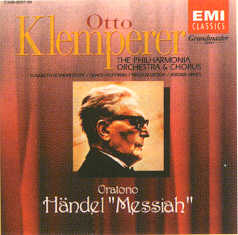 |
3)
HÄNDEL ; Oratorio "Messiah" - Otto
Klemperer/Philharmonia Orchestra & Chorus,
Solists ... Sound quality is not fairly good. Low resolution is unpleasant as if behind a curtain, and volume saturation peculiar to the Grandmaster(HS-2088) series..... |
4) MAHLER ; Symphony No.9 in D major
- John Barbirolli/Berlin Philharmonic
- Record No. ; TOCE-3039
- Contribution ; Hwaseop LIM, The Classical Music, No.1(June 1996) [ by courtesy of the author ]
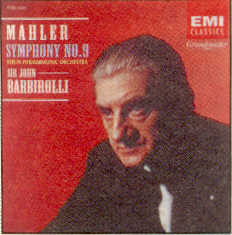 I have some doubt on
HS-2088 series by Toshiba from last year('95). Surely,
this series completely sounds different from former
issues, but is it better? What did they do at the
original sources on earth?
I have some doubt on
HS-2088 series by Toshiba from last year('95). Surely,
this series completely sounds different from former
issues, but is it better? What did they do at the
original sources on earth?
On the whole, it is sure that HS-2088
sounds better than former issues. In special, Furtwangler
series are surprisingly different and vocal works was
eminent in reissued ones. But, in these items, many
record collectors say that orchestral sound becomes lean.
Better and easier to listen, I cannot know whether it was
really original or good makeup by Y.Okazaki,
the series remaster engineer.
I want to say in this review whether
the sound of this issue(TOCE-3039) is more natural than
former one(CDM 7 63115 2)... Studio series issue
is fairly different from this HS-2088 issue. The former
has low signal level and decreased background hiss noise
much. I think it is fairly successful remastering(maybe
original LP listeners are not satisfied, of course). The
signal level of latter is considerably higher and did not
decrease hiss much. The most different thing is that the
treble(in special, violin) is unpleasantly rough. Of
course, it maybe results from high resolution, but I
think too much increse of resolution was done. Moreover, I was suspicious that volume
saturation took place at ff due to high signal level. Why so?
| I compared playing time of these two issues. HS-2088 is longer by 14 seconds in 1st movement, and others are not so(it's frequent to be different by about 5 second in remastering CD, and blank time can cause it). Toshiba's former version(not HS-2088) has the same jacket to Studio issue, and it has almost no difference from Studio in playing time, judging from CD back jacket. |
|
| I think one can have suspicion only by playing time of 1st movement. Toshiba's former issue and international version has same playing time, but HS-2088 has serious difference. Of course this don't result in easily discernable difference*, but suffices to say that I have suspicion that there was quite many manipulation by Y.Okazaki in remastering... Of course, as in their advertising this series, maybe they do in this style in order to 'activate the natural nuances of Analogue master'. But at least in orchestral works, do only I have strange feeling to the engineer's saying? |
* Footnote by Youngrok LEE; This is 0.87%, about 3.8Hz higher in case of reference A note(=440Hz), which is detectable by trained listeners and string players. In case of 2nd movement of Schubert's 'Unfinished' by Furtwängler, the difference is 1.49%(different by 10sec from 670sec total), which causes 6.6Hz lower pitch in reference A. I can discern it without fail.
********************************
These are only representative cases. Reissues of Dinu Lipatti's recording has problems of volume saturation and harsh sounds(Taejin KIM, The Classical Music, No.3), which are usually pointed out by Korean reviewers.
Let's make a conclusion. I have
pretty many experiences in listening HS-2088 series, but
cannot say that there is always a positive side to buy
this series on the whole. I inspected the differences
between HS-2088 and international versions(and older one
of Toshiba) including orchestral works(Furtwängler,
Klemperer's), vocal(Schwarkopf's), and solo(Gieseking, Walcha, S.Richter's), and can't help concluding so(The Classical Music,
No.5). Especially to
collectors to have international version already, I
definitely want to say "It is not necessary to change them
by HS-2088 except for some items".
Then, Why did Toshiba's staffs
release this series and advertise so much? Really did
they think they enhanced sound quality? Or did they have
no ability to make such a decision? I can't know...
(c) 1996~ , Youngrok LEE ; Link free, but please get my approval before you reuse, copy, or quote this materials.
| Music Home | All lists | Beethoven | Brahms | Schubert | Others | Liner Notes | Tedious | License(Korean) | Hall of Shame | Korean |
Created ; 26th Dec. 1999
Last Update ; 17th Jan. 2001
